Swanky Syd and the Bunny Girl
- Home
- World War I Articles
- Swanky Syd and the Bunny Girl
Last summer [2021] a friend gave me a copy of Bombshell: The Night Bobby Kennedy Killed Marilyn Monroe (London: Ad Lib Publishers, 2021). This is not a book I would have bought myself, but I make it a point of honour to read anything gifted to me. I’m glad I did.
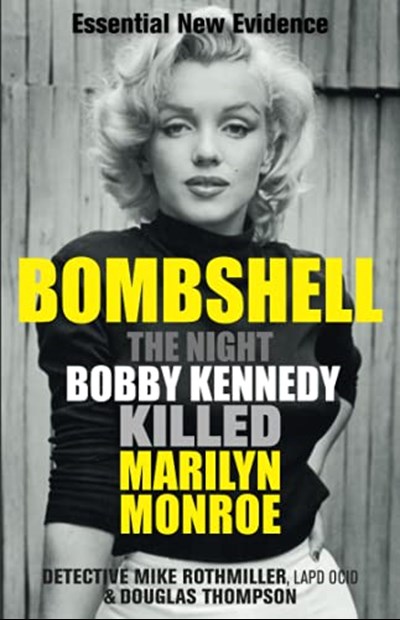
I have no idea whether Bobby Kennedy killed Marilyn. The case is based on hearsay and illegal surveillance that would never have reached court, but there is a mountain of credible evidence showing a number of individuals and institutions in a very bad light. These include the Kennedys, the Los Angeles Police Department, the FBI (J. Edgar Hoover thought Monroe was a Communist!),the CIA, Frank Sinatra and the film star Peter Lawford, the brother-in-law of Jack and Bobby Kennedy.
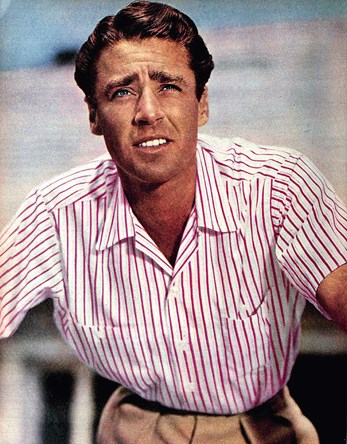
Above: Peter Lawford, in 1955
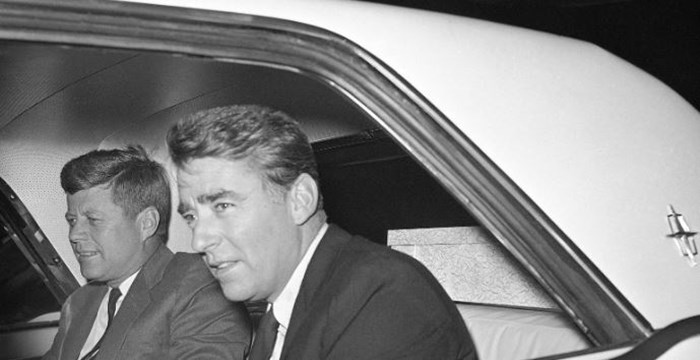
Above: John F. Kennedy, President-elect in car after his arrival on Jan. 11, 1961 in West Palm Beach, Florida from Washington on right is his brother-in-law Peter Lawford who accompanied the President-elect from the nation’s capital. Mr. Kennedy with a busy schedule ahead hoped to get in some work on the inaugural address he will deliver on January 20. (AP Photo)
Lawford emerges from the narrative as a sad, even tragic, figure. He was, of course, the son of Lieutenant-General Sir Sydney Lawford (‘Swanky Syd’) (1865-1953), the only man to command 41st Division during the Great War, and a fine soldier. Reading the book made me look again into the private life of Peter Lawford’s father.
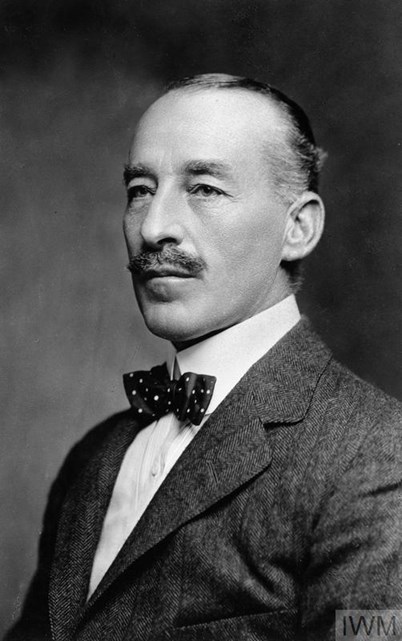
Above: Brigadier General Sydney Turing Barlow Lawford (IWM HU 118535)
I am struck by how many senior British officers had long, stable and happy marriages, often to women much younger than themselves.(1) There are always exceptions, of course. Sydney Lawford was one of them. He was married three times and divorced once. Little is known about his first two marriages, but his third marriage, to May Aylen (née Bunny), figures prominently in two published accounts, his wife’s ineffable Bitch! The Autobiography of Lady Lawford as Told to Buddy Galon (Brookline MA: Branden Publishing Co., 1986) and James Spada’s biography of his son, Peter Lawford: The Man Who Kept the Secrets (Bantam Books, 1991). Spada was a well-known author. He also wrote biographies of Bette Davis, Grace Kelly, Marilyn Monroe and Barbra Streisand. He had a regard for facts and his books were the product of diligent research. His biography of Peter Lawford corrects many of the errors and omissions of the Galon book, but also uncritically accepts as true some of Lady Lawford’s ‘memories’ as recounted by Mr Galon. And it is with Mr Galon that we must begin.
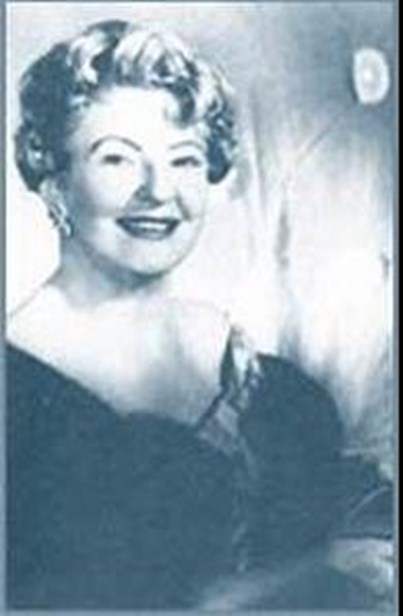
Above: May Lawford (1883-1972), General Sydney Lawford's third wife.
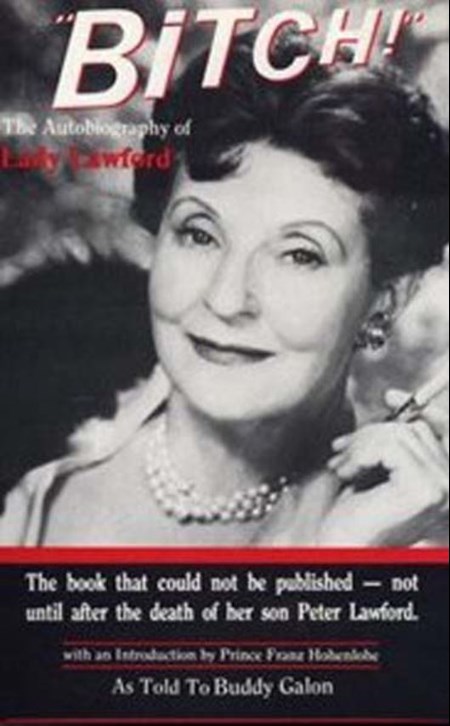
Above: Bitch! The Autobiography of Lady Lawford as Told to Buddy Galon (Brookline MA: Branden Publishing Co., 1986)
‘Desperately Seeking Buddy Galon’(2)
According to James Spada, Galon was introduced to Lady Lawford in 1966 by her friend Thelma Keaton, the widow of Buster Keaton. Mrs Keaton had heard Galon, described by Spada as a twenty-five year old theatre student at the University of California, Los Angeles [UCLA], speaking on the subject of reincarnation. Lady Lawford was interested in reincarnation and it was one of many subjects about which she troubled the newsprints from time to time. There is no doubt that Lady Lawford and Buddy Galon became close friends. He was someone a lonely old woman could reminisce with and have her view of the world validated. Galon even claims that they were married in 1968, when he was 29 and she was 85!(3)
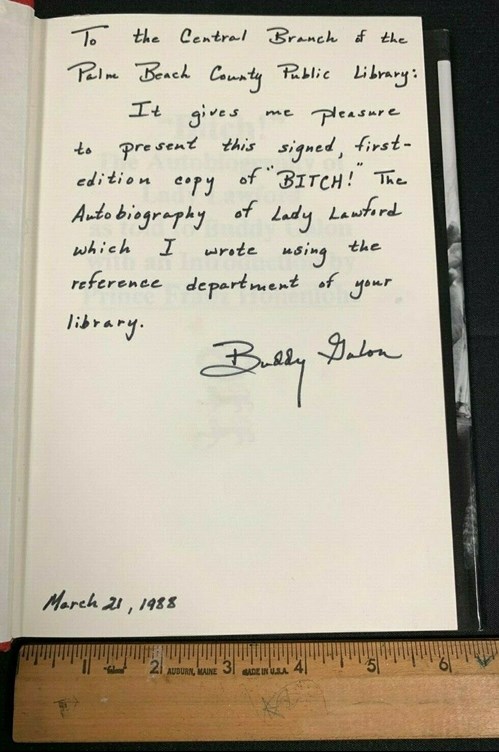
Above: A signed copy of the book, with Buddy Galon's signature (ebay)
In Bitch!, and elsewhere, Galon makes claims about himself and his career: He had undertaken doctoral studies at Oxford and the Sorbonne. He had been a ‘Hollywood stage, television and motion picture personality’, who had begun his entertainment career as a Walt Disney child performer. He had retired after a career directing Lucille Ball films. He had been a celebrity talk show host. The Youth in Film Association and the Florida Motion Picture and Television Association had honoured him with Lifetime Achievement awards. The UCLA School of Education had named him “Educator of the Year”. Like Lady Lawford, he saw himself as an ‘aristocrat’, which meant that he was ‘equally at home in the company of royalty, nobility, world leaders, or the greats of Hollywood’.(4) Or perhaps not. It has not proved possible to substantiate any of Galon’s claims, which should be straightforward if any of them was true. To give one example, you would at the very least, given what he says about himself, expect his name to appear in the Internet Movie Database [IMDb], which has hoovered up virtually everyone, however minor, in the history of the American film and television industry, but it does not.(5)
It is not clear how Galon recorded his meetings with Lady Lawford. These consisted of invitations to May’s four o’clock afternoon teas, but also involved long telephone conversations, often lasting several hours. Did he tape record conversations? Did he make notes as she was speaking? Did he write up the conversations later? If so, how much later? Whatever method he used, it produced some extraordinary passages. On pp. 18-19 of Bitch! Lady Lawford is described drawing Galon’s attention to a framed copy of Sir Jocelyn Lucas Bt.’s letter of appreciation to The Times after Sydney Lawford’s death. Lady Lawford then referred to a photograph of her husband. Galon’s account is sheer gibberish:
‘In this picture, you can see why his men called him “Swanky Syd”. You see, he was always impeccable. That is old Seafoam standing next to the General in that picture. We called him Seafoam, but that was a slang word – because he liked a whisky bottle that comes like that, you know. But he isn’t the one who sent the commendation to the General; Sir Jocelyn Lucas, who was his Aide-de-Camp the whole of the war [my emphasis], sent it, and no bigger damned fool ever lived because one day when they delivered to the Prince and his soldiers – the Prince had departed from there and left nothing but the Germans in front. That’s when he got two horses shot from under him. When the Prince departed, Sir Sydney turned to Sir Jocelyn and said , “Jocelyn take this letter to Page” – Page was Commander-in-Chief, who at that time was over him in command. And he said, “Take this to Page and tell him the British are gone. We are faced with nothing but four German divisions and there are but two of us. Don’t worry; they are as good as dead”. Some man – the General!’(6)
Where Bitch! is concerned, it is a case of ‘reader beware’!
The Lawfords
May Aylen was not averse to inflating the social status of the Bunnys, but she clearly thought that in marrying Sydney Lawford she had moved up a rung on the social ladder. This was not only because Lawford was a knight and marrying him made her a Lady but also because she thought the Lawfords were of a superior social class. When the scandal of their divorces compelled them to leave the country, May explained that Lawford was distressed to have to leave behind his ancestral home. The Lawfords did not have an ancestral home or ancestral acres. The family does not appear in Edward Walford’s The County Families of the United Kingdom (1st edn., 1860) or John Bateman’s The Great Landowners of Great Britain and Ireland (4th edn., 1883). The family’s fortunes were made in finance, specifically stockbroking. The family was largely unknown to fame or wealth until the time of Lawford’s paternal grandfather, Samuel (1777-1864), and his wife Margaretta Sarah Dunsford Acland (1782-1869), who came from two well-known Tiverton families, engaged in trade and banking. (7) Samuel and Margaretta settled in middle-class Blackheath, where they raised a large family.(8) Their seventh child was Thomas Acland Lawford (1816-84), Sydney Lawford’s father.
Thomas Acland Lawford married Jessie (‘Janet’) Turing Bruce (1828-88), the daughter of a bill broker. They had seven children, of whom Sydney Turing Barlow Lawford was the youngest. He was the only son to follow a military career. His brothers remained in the City. Herbert Fortescue Lawford (1851-1925) and Archibald Duff Lawford (1858-1903) became stock brokers and Members of the Draper’s Company.(9) Ernest Bruce Acland Lawford became an accountant and later married Lady Gertrude Montgomerie, daughter of the 14th Earl of Eglinton.(10) They all did well financially.(11)
May Lawford explained to Buddy Galon that while the Bunny sisters married ‘high-ranking officers in the British army’, which is somewhat contentious, the Lawford sisters married ‘titles’. The only Lawford sister with a claim to having married a ‘title’, however, was the youngest, Ethel Turner Lawford (1860-1959), whose husband was the Hon. Rolfe Arthur Lubbock (1865-1909), son of John Lubbock, 1st Baron Avebury (1834-1913), banker, politician and polymath. Rolfe Lubbock was, however, also a stockbroker, a Member of the Stock Exchange, who worked for the family firm, Lubbock Vertue & Co. Ethel Lubbock’s marriage was childless. May claimed with typical exaggeration that Ethel died a ‘millionairess’, but refused to leave any money to Peter Lawford because he had ‘become an actor’. She actually left £39,342 17s 7d. Lawford’s oldest sister, Jessie Bruce Lawford (1849-1933), married (as his second wife) Sir Hartley Eyre Williams (1843-1929), a wealthy Australian barrister, who became a member of the Supreme Court of Victoria before retiring to England. Evelyn Gertrude Turing Lawford (1857-1944) also married a stockbroker, Charles Herbert Stanley (1852-1931), though one not nearly as wealthy as her brothers.
When May Aylen married Sydney Lawford she was therefore not marrying into aristocratic landed society, but into a comfortably off, even wealthy, City and professional middle-class family. Sydney Lawford was to prove the exception to the family rule in more senses than one.
The Bunnys
The Bunnys were a well-known family in the Newbury area of Berkshire, the successful descendants of a grocer, Blandy Buck Bunny. They were bankers and lawyers and also soldiers. May Bunny’s paternal great grandfather, Jere Bunny (1789-1854), was Lord of the Manor of Speen Hill and a solicitor in Newbury, who married the daughter of a brewer. They had a large family, ten of whom survived into adulthood. In the words of the British Library Untold Lives Blog: ‘The Bunny Family of Berkshire’, the lives of these children ‘took many different paths: vicar’s wife, soldier, farmer, fugitive, solicitor, gold miner’.(12) It is the soldier who concerns us.
Arthur Cautley Bunny CB (1825-83) was May Bunny’s paternal grandfather. He was commissioned in the Hon. East India Company’s Bengal Artillery, later transferring to the Royal Artillery and retiring as a major-general. Arthur Bunny and his wife had three sons, all of whom followed military careers. Arthur Cautley Bunny (1852-97), Indian Army, was killed in action on 10 June 1897 in the Tochi Valley while commanding 1st Sikh Infantry, Punjab Field Force. Frederick Brice Bunny (1853-1930) retired as a Colonel in the Royal Artillery. Frank William McTier Bunny (1860-1940) is usually referred to in print (and certainly by his daughter May) as ‘Colonel, Royal Berkshire Regiment’. He did, indeed, begin his military career in the Berkshires, but he never rose above the rank of major. His colonelcy was in the Army Ordnance Department, an important post, but without the social caché of command of a ‘Royal’ infantry regiment.
In her reminiscing with Buddy Galon, May Bunny left a very unflattering portrait of her parents that James Spada largely accepted. As an example of their harshness, she told the story of her youngest sibling, her brother (Arthur) Brice Bunny. ‘My brother Bryce [sic] was treated very sternly as a child. Later, he was shot through both arms while serving in India, and he remained shell-shocked for eighteen months before dying. Never once did we go to see him.’ Or perhaps not. Galon indexes Briceas ‘Lieutenant Bunny’ but the highest rank he held was 206062 Gunner Royal Horse Artillery.
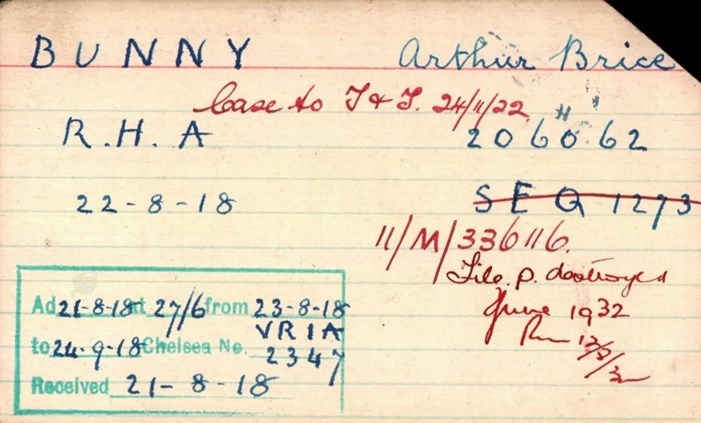
Above: The Pension Record Card for 206062 Arthur Bunny
He served in India from 1917 until his discharge as Permanently Unfit (Sick) on 22 August 1918 at Ambala. His appears to have been a sad life. He died on 26 May 1925, aged 26, at the Berkshire Mental Hospital, Cholsey.(13) He had been under the care of the Training & Treatment Branch of the Ministry of Pensions.(14)
May Bunny was the oldest of four children, three of them girls. Theirs was the experience common to what Americans call ‘army brats’. They led a peripatetic existence as children. May was born in Reading, Kathleen in Kingstown, Co. Dublin(15), Gretta in Trincomalee, Ceylon, and Brice in Stirling. Their mother, Caroline Stanley Todd, died in 1914 while her husband was stationed in Malta.
May’s sisters had marital histories as colourful as her own. Kathleen was married twice. Her first marriage, to Frederick Charles Curme Ensor (1879-1956), a Captain in the Royal Garrison Artillery and the son of a Yeovil master glover, was annulled on 24 March 1914 on the grounds of Ensor’s inability to consummate the marriage. Until recently I had no experience of divorce files. They need to be approached with caution. They are often not what they seem. This was a period when divorce was difficult to obtain, especially for women, and there was no concept of a ‘no fault divorce’. When marriages had broken down, to use a modern phrase, it was common for women first to petition for the ‘restitution of [their] conjugal rights’. This first step was necessary because women, unlike men, had to show two grounds for divorce. After the petition was granted and not acted upon by the man, the woman could petition for divorce on additional grounds, usually the husband’s adultery, which may have been real or contrived. Male adultery did not carry the same social stigma as female adultery, so men were often happy to ‘do the decent thing’ and collude in the fiction of adultery by being ‘discovered’ booking into a hotel with a woman hired for the purpose. Kathleen Bunny’s divorce does not fit this model. It was one thing for a man to admit to adultery, quite another to admit to impotence. At the time of the petition for non-consummation Kathleen and her husband had been married for six years. May claimed that her sister had successfully bamboozled the doctors appointed by the court to examine her into believing she was a virgin. This was not the case because no such examination took place. The Court accepted Kathleen’s ‘medical oath’ and as her husband did not defend the petition it was granted and the marriage annulled.(16)
May describes Kathleen’s second husband, whom she married in 1914, as ‘a very tall man – six foot four – and a very fine cavalry officer’. She claimed that he ‘inherited from his mother and father … a big, huge estate in the forest [that] used to belong to Robin Hood’! She also claimed that Dyer later became a general and Sydney Lawford’s Chief of Staff in India. This was pure fantasy. Kathleen’s second husband was Howard Geary Dyer (1881-1959), an officer (Major, later Lieutenant-Colonel) in the Royal Army Service Corps, and the son of a Hampshire GP. At his death on 9 November 1959 at The Royal Hants County Hospital, Winchester, he left precisely £73 16s 9d. Kathleen died at King’s Ford Bungalow, Chandlers Ford, Hampshire, on 22 November 1963, aged 74, leaving £72.
Gretta was also married twice. Her first husband was a subaltern in the Argyll & Sutherland Highlanders, Walter Glencairn Campbell (later Glencairn-Campbell). She divorced him in 1939, though I have been unable to find a Divorce Case File so I do not know on what grounds.(17) She remarried in 1941 to Colonel (later Major-General) Geoffrey Woodroffe Palmer CB (1891-1952), an officer in the Royal Army Ordnance Corps. They went to live in Southern Rhodesia. May claims that after Palmer’s death Gretta worked as a secretary and joined the Rhodesian Women’s Army, where she became ‘alternately known as “the duchess” and the “the bitchess”’. Gretta died in Bulawayo on 12 January 1970, aged 76.
The account of May Bunny’s marital history in Bitch! is convoluted and confusing, but anyone reading it would reasonably conclude that she was married twice and that Sydney Lawford was her second husband. They would be wrong. May was married three times. Her first husband was Harry Ashley Christian Cooper (1867-1905), whom she married in 1902, when he was 34 and she was 18. Cooper was an Indian Army officer and the son of a former HM Consul in China. James Spada argues that Bunny trapped Sydney Lawford into marriage by deliberately becoming pregnant, something she had successfully avoided in her previous marriages. This, too, is wrong. She had a daughter with Cooper. Margaret Mary Cooper was born in Rangoon on 29 March 1903 and died there a few days later on 7 April 1903. The cause of death was given as ‘convulsions’. This child has been entirely edited out of May Bunny’s history. By her own account, May was entirely ignorant of ‘the facts of life’ at the time of her marriage and never became reconciled to sex, which she went to ingenious lengths to avoid. Her frigidity towards Cooper, allied to rumours of her involvement in amateur theatricals and flirtatiousness, seem to have preyed on his mind. On 5 January 1905, Major Harry Cooper, 62nd Punjabis, put a revolver to his head and shot himself. According to James Spada’s account, May was back in England at the time and received the news via a brusque telegram from Cooper’s Commanding Officer.(18)
The young widow did not remain single for long. On 1 November 1906 she married Ernest Vaughan Aylen (1877-1947), an officer in the Royal Army Medical Corps, despite opposition from Aylen’s family, who did not consider the widow of a suicide to be a suitable wife.(19) Aylen, however, was entranced by May’s vivacity and found her company ‘exciting’. May typically inflated Aylen’s status and wealth, claiming that he gave up a lucrative Harley Street practice to join the army, which was pure fiction. Aylen seems to have been more phlegmatic about May’s aversion to sex and the marriage endured until 1923, ‘happily’ according to Aylen, until she met Sydney Lawford in India in 1922.
Swanky Syd and the Bunny Girl
General Lawford was uncharacteristically coy about his own marital history. His entry in Who’s Who lists only his marriage to May. Burke’s Peerage, Baronetage and Knightage lists his second and third marriages, but as his first and second. I find the editing out of history of Lawford’s first wife odd and unfathomable. She was Lilian Maud Cass (1860-1900), the daughter of a wealthy clergyman, the Rev. Charles William Cass (1826-99). They married on 30 September 1893. She was 33; he was 28 and a Lieutenant in the Royal Fusiliers. Lilian Lawford died on 26 November 1900, from lung cancer, aged 40. Lawford was present at her death. There were no children. He did not marry again until 20 May 1914.
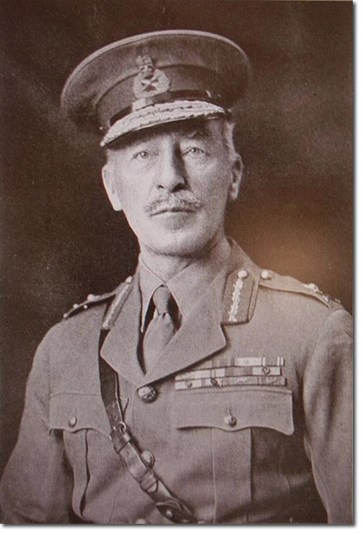
Above: Lt Gen Sydney Turing Barlow Lawford
Lawford’s second wife was Muriel Maud Watt (née Williams) (1880-1936). I presume they were brought together through a family connection. Muriel was the daughter of Sir Hartley Williams by his first wife; Williams’s second wife was Sydney Lawford’s sister. Muriel’s marriage to Lawford meant that Hartley Williams was both Lawford’s brother-in-law and father-in-law! Muriel’s first marriage had been to (Walter) Oswald Watt (1878-1921), the first Australian to obtain a Royal Aero Club flying certificate (1911) and later an important figure in the development of Australian military aviation. She divorced him in September 1913 on the grounds of his misconduct with Ivy Schilling, an actress. She was given custody of their son, James, and awarded costs. She married Lawford eight months later. She was 34. He was 49, a full Colonel and commander of the Essex Infantry Brigade TF. The marriage endured until 1923, though seemingly unhappily for some years before then. It was dissolved on the grounds of Lawford’s adultery with May Aylen.
A general as ‘co-respondent and respondent’ was newsworthy. The Times of 21 February 1924 carried accounts of both cases, Aylen v Aylen and Lawford, and Lawford v Lawford. Both suits were undefended.
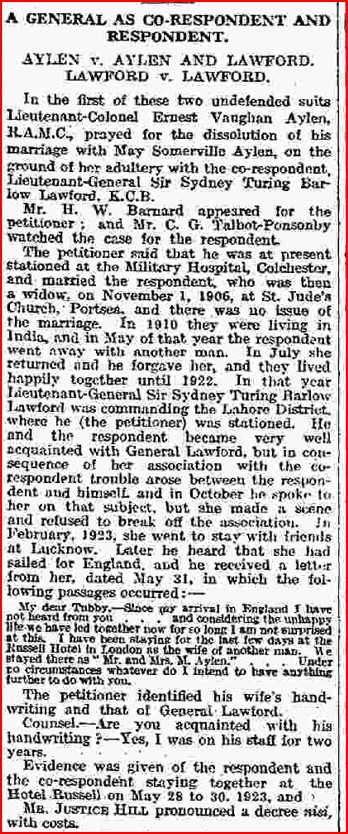
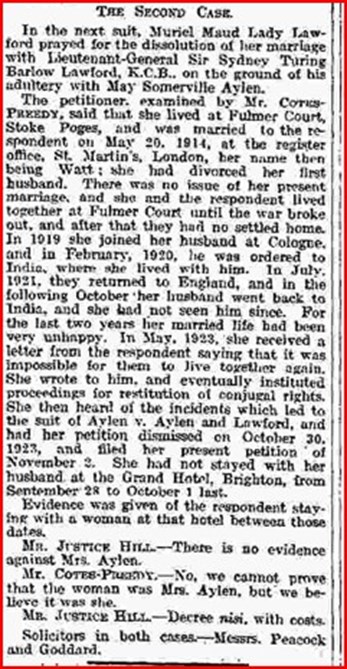
Colonel Aylen testified that in May 1910 his wife had gone away with another man, but she had returned in July and was forgiven. They had lived ‘happily together’ until 1922 when General Lawford became GOC Lahore, where Aylen was stationed. When it became apparent that his wife was becoming close to Lawford, he asked her to break off the association, but she refused, leaving to stay with friends in Lucknow and then sailing to England. On 21 May 1923 she wrote to Aylen: ‘My dear Tubby, Since my arrival in England I have not heard from you … and considering the unhappy life we have led together now for so long I am not surprised at this. I have been staying for the last few days at the Russell Hotel in London as the wife of another man. We stayed there as Mr and Mrs M. Aylen. .. Under no circumstances whatever do I intend to have anything to do with you.’ Evidence was given of Mrs Aylen and Lawford staying at the Russell Hotel from 28 to 30 May 1923. Mr Justice Hill pronounced a decree nisi with costs.(20)
Muriel Lawford had lived with her husband until October 1921, when he was posted to India. She had not seen him since and her married life had become very unhappy. In May 1923 Lawford wrote to her saying that they could no longer go on living together. This led Lady Lawford to petition for the restitution of her conjugal rights, but when she learned of the suit of Aylen v Aylen and Lawford, she withdrew this and petitioned for divorce. Evidence was presented of Lawford staying at the Grand Hotel in Brighton between 28 October and 1 November 1923 with a woman believed to be Mrs Aylen. What was not reported by The Times and apparently not presented in court was that May Aylen gave birth on 7 September 1923 to a son fathered by Lawford. The son’s birth was registered in the name Peter Sydney Ernest Aylen, the future Peter Lawford. (21)
Lawford and May were married on 11 September 1924. The scandal surrounding their union ended Lawford’s military career and the hostility of polite society was enough to force them into a meandering exile. They went initially to France, traditional refuge of British ‘outcasts’, where the weather was warmer and the cost of living cheaper. Peter Lawford spent the first five years of his life there and became fluent in the language, as were his parents. They returned to England in 1930, where the furore over their divorce had died down, but was not entirely forgotten. It was during this period that Peter Lawford’s career as a child actor began, much to the consternation of his father, but with the approval of his mother, who was really a frustrated actress. May also became involved in politics, through her support for Empire Free Trade, including writing newspaper columns for the Beaverbrook press. (She was child of empire and remained an ardent imperialist.)
Sir Sydney’s investments had been badly affected by the Wall Street Crash, but what James Spada calls ‘a modest inheritance’ allowed the family to start travelling again.
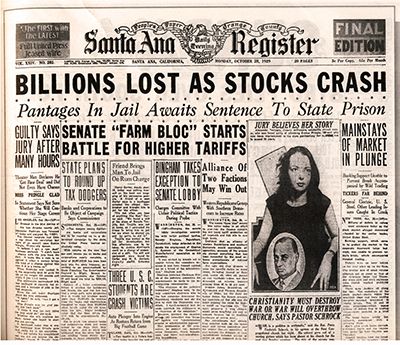
This was partly to fulfil Lawford’s desire to see the world, but also to get his son away from acting. In Spada’s words, ‘over the next five years [from 1932], the Lawford family would not live in any one region of the earth for more than nine months at a time’. They travelled to ‘India, Australia, Tasmania, Tahiti, Colombia, Brazil, Hawaii, Spain, Portugal, Ceylon, Bermuda, Panama, Cuba and the USA’. After a serious accident to Peter Lawford’s right arm, while they were staying in France, doctors advised them to seek a warm climate. They chose the warm climate of California. They arrived in 1937. Lawford and his wife were destined to spend the rest of their lives there. Hollywood was a strange choice if Lawford wished to keep his son away from acting. It is difficult not to believe that he had been ‘played’.
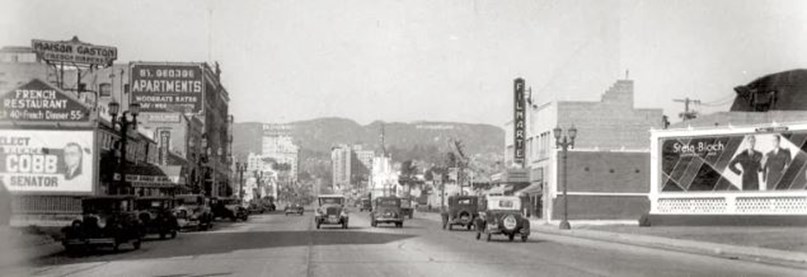
Above: Vine Street, Hollywood, from around La Mirada Ave (taken in 1937)
If Lieutenant-General Sir Sydney Lawford had given any thought to the future during his time as GOC Lahore, he could never had imagined what lay ahead after his meeting with Mrs Aylen. It is difficult to know what Lawford felt about his life in Hollywood. All we know is refracted through the distorting prism of the memories of his wife and son. He seems to have been quite content and eventually reconciled to his son’s film career. He died peacefully after a bout of influenza on 15 February 1953, aged 87.
Peter Lawford adored his father and loathed his mother, who was alternatively smothering and indifferent. She was also extraordinarily embarrassing. She drank too much and was not shy of expressing her opinions on many subjects, often in inappropriate company. She made no secret of her contempt for her son’s in-laws, the Kennedys, whom she dismissed as ‘barefoot Irish peasants’.

Above: Actor Peter Lawford with his brother-in-law President John F. Kennedy aboard the yacht "Manitou"
She emerges from the pages of James Spada and (inadvertently) from the pages of Buddy Galon as a liar, a fantasist, a snob, a social climber, an anti-semite and an appalling mother. She died on 23 January 1972, aged 88. Mr Galon would later claim that she had been murdered to keep her from revealing secrets about her son’s friends and relatives. (22) Quite.
J.M. Bourne
John Bourne taught History at Birmingham University for thirty years before his retirement in September 2009. He founded the Centre for First World War Studies, of which he was Director from 2002 to 2009, as well as the MA in British First World War Studies. He has written widely on the British experience of the Great War on the war front and the home front. He is currently completing a multi-biography of Britain’s Western Front Generals. He is a Vice President of The Western Front Association, a Member of the British Commission for Military History, a Fellow of the Royal Historical Society and Hon. Professor of First World War Studies at the University of Wolverhampton.
Notes
(1). The propensity of officers to write to their wives produced some classic accounts, notably Rowland Feilding’s War Letters to a Wife: France and Flanders, 1915-1919 (London: Medici Society, 1929), Philip Howell: A Memoir, by His Wife (London: Allen & Unwin, 1942) and Frank Maxwell Brigadier-General VC CSI DSO. A Memoir and Some Letters edited by his wife (London: John Murray, 1921). More recently, important collections of First World War generals’ letters have appeared: see Nicholas Perry, ed., Major-General Oliver Nugent and the Ulster Division 1915-1918 (Stroud: Sutton Publishing for the Army Records Society, 2007), the core of which is the 600 letters Nugent wrote to his wife, Kitty, and Edward Pereira, Spencer Jones &Michael LoCicero, eds., Catholic General: The Private Wartime Correspondence of Major-General Sir Cecil Edward Pereira, 1914-19 (Warwick: Helion, 2020), which consists principally of letters to his wife, Helen.
(2). In August 2009 Charlotte Booker presented a play based on Bitch! at the New York Fringe. She also set up a Google alert on the name ‘Buddy Galon’. This resulted in a series of messages beginning on 21 August 2009. On 14 September 2009 it became clear that she was not alone in looking for Buddy. "Has anyone seen Buddy Galon, the author, who once lived in Palm Beach? He has disappeared without a trace. . ."
(3). To give an idea of Mr Galon’s relationship to facts, a reviewer of Bitch! in the Los Angeles Times on 28 September 1986 raised an eyebrow at the disparity in ages between Galon and Lady Lawford at the time of their alleged marriage. Galon felt compelled to complain, adding that ‘her last husband Sir Sydney Lawford was 45 years older than she was’. He was actually 18 years older; he was 58, she was 40.
(4). The endpaper of Bitch! has a photograph of Galon captioned ‘The author stands in front of the suspended staircase of his family’s ancestral home’. His ‘ancestral home’ was Woburn Abbey, seat of the Dukes of Bedford! The photograph is an obvious fake.
(5). According to the US Federal Census of 1940, ‘Buddy Galon’, given name Beauregard Ogletree, was born in March 1939 in Butts County, Georgia. His parents were Alton R. Ogletree (1904-63), a Baptist Minister, and Imadelle Ogletree (née Jones) (1909-2003). Both his parents were the children of farmers. He had an older brother, Sidney Jones Ogletree (1932-96), who became a Savings & Loan Branch Manager in Fort Walton Beach, Florida.
(6). Sir Jocelyn Lucas Bt. (1889-1980) was not Lawford’s ADC ‘the whole of the war’. He was captured in 1914 and spent the rest of the war as a PoW. This is apparent from the letter quoted on the previous page! Who was the Prince? Is ‘Page’ a mishearing or mis transcription of ‘Haig’? Who knows?! One reviewer described Bitch! contended that ‘It's unlikely that [the book] contains more than a few grains of truth or actual statements by Lady Lawford herself, as the style is completely American slang and sounds as if written by a 17-year-old’. It is certainly often difficult to know where Lady Lawford ends and Buddy Galon begins.
(7).Margaretta Lawford’s father, Gideon Acland (1744-99), was one of the Tiverton ‘radicals’ and an associate ofthe Dunsford brothers, George and Martin. Martin Dunsford was the leading opponent of the Tiverton Corporation and the historian of the town. See John Bourne, ed.,Georgian Tiverton: The Political Memoranda of Beavis Wood 1768-98 (Exeter: The Devon & Cornwall Record Society,1986).
(8). Samuel Lawford left estate valued at ‘under £12,000’ at his death.
(9). I couldn’t help noticing a comment in the recent obituary of Clarissa Eden, Countess of Avon: ‘Anne Clarissa Spencer-Churchill was born in London in 1920. Her father, Jack, Winston Churchill’s younger brother, who had won the DSO in the First World War, worked as a stockbroker. This was not yet regarded as the profession of a gentleman’ [my emphasis],The Times, 17 November 2021.
(10). Herbert Lawford married his cousin Edith. Archibald Lawford married Lucy Doke, daughter of William Woodward Doke, stockbroker.
(11). Hebert Lawford left estate valued at £86,221 8s 11d, Ernest Lawford left estate in England valued at £31,022 14s 1s (he died in Jersey) and Archibald Lawford left estate valued at £56,172 7s 0d. Herbert was a well-known tennis player, who won Wimbledon in 1887 and was runner-up five times, which is still a record. His other claim to fame is that he invented the topspin forehand.
(12). The fugitive was Henry Bunny, former Town Clerk of Newbury, who fled to New Zealand to escape his debts, eventually entering New Zealand politics. He committed suicide in 1891.
(13). The cause of death was ‘1. Epilepsy some years; 2. Lobar pneumonia 2 days’.
(14). I am once more indebted to Craig Suddick for his help in interpreting pension records.
(15). Kathleen liked to style herself as ‘Irish’. See the Retford and Worksop Herald & Leader, 2 July 1918, when she was quoted in court as saying ‘It’s no good having horses to hunt with these d[amne]d dogs. I am Irish and if you upset me you will be d[amne]d’. The report of the case was headlined ‘NOTTS HUNTING SCANDAL’. Astonishingly, given the evidence reported, Kathleen received damages for libel. Truly, after reading this report, you would not have known that Britain was involved in the greatest war in its history.
(16). May typically claimed in Bitch! that the doctors appointed by the court were the ‘King and Queen’s doctors’. They were not. She also said that her sister had been married for only a year when her marriage was annulled. She had been married for six years. Ensor remarried in 1923. His second wife had been sued for divorce by her husband, Lieutenant-Colonel Sydney Hugh Duxbury, on the grounds of her adultery with Ensor, which does not suggest that he was incapable of sexual relations.
(17). Walter Glencairn-Campbell (1889-1944) remarried in 1940 to the nineteen-year old Charmian Brinton, of the famous Kidderminster carpet family. Despite Glencairn-Campbell being a divorced man whose first wife was still alive, they had a large society wedding at Holy Trinity, Brompton. Brigadier Glencairn-Campbell died in 1944 after being operated on for a gastric ulcer in the Queen Elizabeth Hospital, Birmingham.
(18). I have been unable to confirm where May was when her husband committed suicide. Somewhere along the line, writers – including, regrettably, this one – have contributed to the legend that May’s husband had shot himself in front of her, though the husband in question in this account was her second husband not her first, which is clearly nonsense.
(19). Suicide was, of course, illegal at this time and carried an enormous social stigma. James Spada has argued that the Aylen family were also concerned about May’s ‘dusky’ complexion! Aylen’s father Samuel was a Clerk in HM Customs and, apparently, something of a puritan.
(20). Readers of Bitch! will seek in vain for an account of Lady Lawford’s divorce from Ernest Aylen. Instead, she tells us that the marriage was annulled after her father arranged a financial settlement.
(21). Neither Muriel Lawford nor Colonel Aylen remarried. Muriel died in 1936, in South Yarra, Victoria, aged 56. She continued to style herself ‘Lady Lawford’. Interestingly, in the New South Wales, Australia, Index to Deceased Estate Files, she is described as a ‘widow’. Aylen committed suicide on 12 October 1947 with an overdose of barbiturates after being diagnosed with cancer of the larynx. He was 70. He had been living at The Three Crowns Hotel, Angmering-on-Sea, Sussex.
(22). Who Killed Lady Lawford? was published by Branden Books in 2012. It is a reworking of the Galon-Lawford relationship, but focusing on Lady Lawford’s death. The book was edited by Adolph Caso, who is probably worth an article in his own right. The text was clearly reworked in the light of James Spada’s biography of Peter Lawford, though this does not save it from gross exaggerations and confusions. The book may best be described as Bitch! on steroids.
Acknowledgements
[Special thanks to Graham Lawrence for sending me down this path and, as always, to Su Handford for invaluable help with the research. I am grateful to Andrea Hetherington for a careful reading of a previous draft. I should also like to thank the Rev. Canon Martin Stephenson for his advice on divorce and remarriage in the Church of England.]





